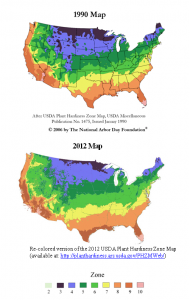We have much more to do and your continued support is needed now more than ever.
New Plant Hardiness Zones Confirm What Gardeners Already Know about Global Warming
 Gardeners who have noticed some unusual goings-on had their suspicions confirmed this week, and the culprit is global warming.
Gardeners who have noticed some unusual goings-on had their suspicions confirmed this week, and the culprit is global warming.
The U.S. Department of Agriculture yesterday released a new map of plant hardiness zones, which confirms what many gardeners had already figured out. Plant hardiness zones, based on minimum winter temperatures, are marching northward. This means that plants that wouldn’t have survived through the winter just 20 years ago are now making it just fine.
Comparing the new 2012 map to the last map USDA published in 1990 shows some significant shifts, especially across the Great Plains. Though the USDA cautions that not all the changes to the map can be attributed to climate change, it is clear that the major shifts are related to warmer temperatures. For example, Iowa and Nebraska used to straddle Zones 4 and 5, but now fall almost entirely within the warmer Zone 5.
Global Warming is Affecting Our Gardens
Although it may be obvious to many of us, it does bear stating that these zones are moving because of global warming. Most areas in the continental United States have warmed by 1-2 degrees F during the last 50 years. This warming has brought shorter and less severe winters. Indeed, we’ve been setting many fewer record lows each winter.
While some gardeners may welcome the opportunity to experiment with new plants, these shifting zones only tell part of the story of how climate change is affecting our gardens. Winter temperatures are not the only thing that affects how plants grow. For example, climate change is bringing more weather and climate extremes that can be quite challenging for plants. Summertime heat and humidity have been increasing. Droughts are becoming more severe. Heavy precipitation events are becoming even heavier, increasing the likelihood of devastating floods. The bottom line is that while you may be able to grow some new plants given the warmer winter temperatures, some old favorites may have a harder time as summer temperatures increase and precipitation patterns change.
Shifting plant hardiness zones also opens the door for harmful invasive species, pests, and diseases. Unfortunately, research is showing that climate change favors the spread of these less desirable species. Gardeners in the Midwest and Northeast will not be happy to hear that the northernmost range of kudzu—the “plant that ate the South”—has already moved northward, with sightings from Southeastern Nebraska to Western Pennsylvania. This latitudinal shift has been attributed to increases in winter temperatures.
Pests that used to be kept in check by hard winter freezes are also expanding their range northward. For example, the range of the red imported fire ant in the United States has historically been limited by cold temperatures and winterkill. Now scientists project that the fire ant range could expand northward by about 80 miles and expand in total area by 21 percent as climate change makes new areas suitable for their survival.
Gardeners Can Help Tackle Global Warming
As guardians and stewards of our environment, gardeners can take many simple and thoughtful steps to work with nature to solve the challenges posed by global warming. NWF’s The Gardener’s Guide to Global Warming: Challenges and Solutions provides many excellent recommendations, including:
- Reduce the use of gasoline-powered yard tools that put carbon pollution, the root cause of global warming, into the atmosphere.
- Remove invasive plants from the garden and choose an array of native alternatives.
- Reduce water consumption, which will improve the resiliency of your garden during droughts and heat waves, reduce energy consumed to transport water; and reduce runoff of fertilizer into waterways.
- Plant lots of native trees and native grasses to absorb carbon dioxide from the atmosphere and serve as long-term carbon storage.





















